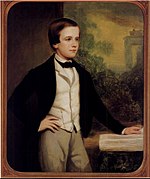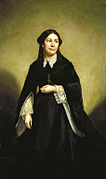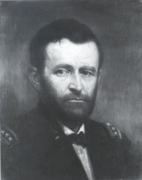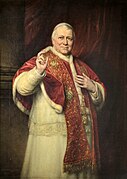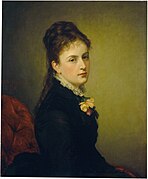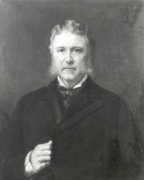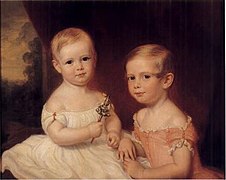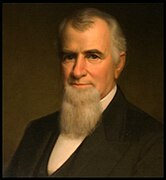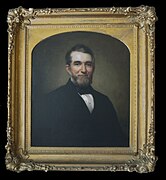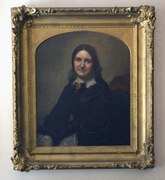George Peter Alexander Healy
George Peter Alexander Healy | |
|---|---|
Chicago, Illinois, U.S. | |
| Nationality | American |
| Known for | Painting |
| Notable work | The Peacemakers Abraham Lincoln |
George Peter Alexander Healy (July 15, 1813 – June 24, 1894) was an American portrait painter. He was one of the most prolific and popular painters of his day, and his sitters included many of the eminent personages of his time. Born in Boston, he studied in Europe, and over his lifetime had studios in Paris and Chicago.
Biography

Healy was born in
Having been left fatherless at a young age, Healy helped to support his mother. At sixteen years of age he began drawing, and at developed an ambition to be an artist. Jane Stuart, daughter of Gilbert Stuart, aided him, loaning him a Guido's "Ecce Homo", which he copied in color and sold to a country priest. Later, she introduced him to Thomas Sully, by whose advice Healy profited, and gratefully repaid Sully in the days of the latter's adversity.
At eighteen, Healy began painting portraits, and was soon very successful. In 1834, he went to Europe, leaving his mother well provided for, and remained abroad sixteen years during which he studied with

In 1855 he returned to the United States, establishing his home and studio in
Healy went back to Europe in 1869, painting steadily, chiefly in Rome and Paris, for twenty-one years. In 1892, he returned to live near family in Chicago, where he died on June 24, 1894.[2] He was buried at Calvary Cemetery in Evanston.
Healy's autobiography, Reminiscences of a Portrait Painter, was published in 1894.[1]
Works
Healy was one of the most prolific and popular painters of his day.[2]
Among his portraits of eminent persons are those of
Healy also paintedHis principal works include portraits of Lincoln (Corcoran Gallery), Bishop (later Cardinal) McClosky (bishop's residence, Albany), Guizot (1841, in Smithsonian Institution),
The Newberry Library in Chicago holds 41 of Healy's paintings, donated by the artist in 1887. Most of the works can be found on display throughout the building. The Newberry also holds some letters by Healy, as well as information about the paintings.[6]
Healy's 1877 portrait of a young Lincoln was the model used for a Lincoln postage stamp, issued on February 12, 1959, the 150th anniversary of Lincoln's birth.
Gallery
-
Euphemia White Van Rensselaer, 1842, MET DT2051
-
John C. Calhoun, c. 1845
-
James Knox Polk, 1846
-
Henry Wheaton, c. 1847
-
Richard Washington Corbin, 1850
-
Millard Fillmore, 1857
-
John Quincy Adams, 1858
-
Martin Van Buren, 1858
-
James Knox Polk, 1858
-
Franklin Pierce, 1858
-
James Buchanan, 1859
-
Dr. William Grosvenor, 1859
-
Sallie Ward, 1860
-
Orestes A. Brownson, 1863
-
John Tyler, 1864
-
William Tecumseh Sherman, 1866
-
Eleanor Boyle Ewing Sherman, 1868
-
The Peacemakers, 1868
-
Ulysses Simpson Grant, 1868
-
Abraham Lincoln, 1869
-
Pope Pius IX, 1871
-
Carol I of Romania, 1873
-
Jennie Byrd Bryan Payne, 1874
-
Roxana Atwater Wentworth, 1876, National Gallery of Art
-
Chester Alan Arthur, 1884
-
Self-Portrait, 1886
-
The Wetmore Boys
-
Helen Edwards
-
Judge George Judd
-
Lucy Judd
References
- ^ a b c Hunt 1913.
- ^ a b c d Chisholm 1911.
- ^ a b "George Peter Alexander Healy (1813–1894)". Illinois Historical Art Project. Retrieved May 10, 2020.
- ^ "Elmhurst". DuPage County Historical Society. September 23, 2019. Retrieved May 10, 2020.
- ISBN 978-0-8139-1489-3. Retrieved May 12, 2021.
- ^ "Visual Art | Newberry". newberry.org.
Attribution:
- This article incorporates text from a publication now in the public domain: Chisholm, Hugh, ed. (1911). "Healy, George Peter Alexander". Encyclopædia Britannica. Vol. 13 (11th ed.). Cambridge University Press. p. 122.
 This article incorporates text from a publication now in the public domain: Hunt, Leigh Harrison (1913). "George Peter Alexander Healy". In Herbermann, Charles (ed.). Catholic Encyclopedia. New York: Robert Appleton Company.
This article incorporates text from a publication now in the public domain: Hunt, Leigh Harrison (1913). "George Peter Alexander Healy". In Herbermann, Charles (ed.). Catholic Encyclopedia. New York: Robert Appleton Company.






